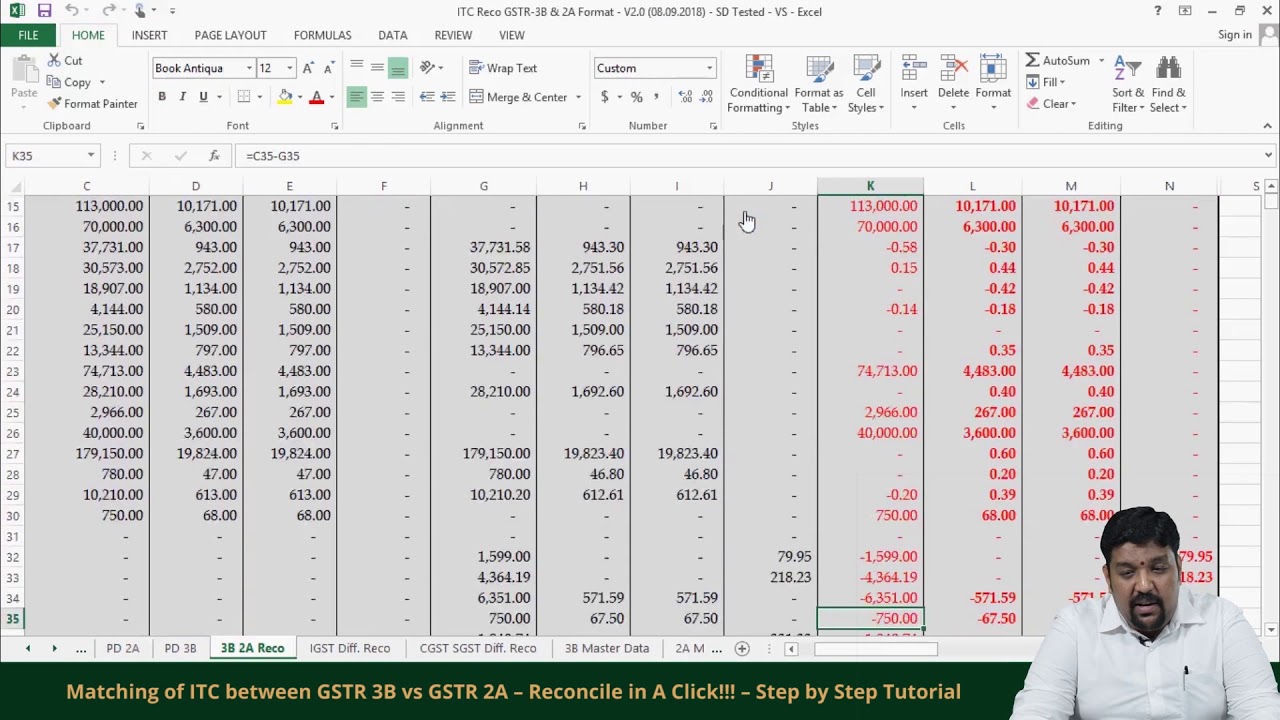Understanding the Importance of GSTR-2A & GSTR-3B Reconciliation for Accurate Reconciliation
- 25 Aug 24
- 11 mins

Understanding the Importance of GSTR-2A & GSTR-3B Reconciliation for Accurate Reconciliation
Key Takeaways
- Accurate ITC Claims: GSTR-3B and GSTR-2A reconciliation ensures correct Input Tax Credit claims, aligning with actual supplier tax liabilities.
- Identify Discrepancies: Regular reconciliation helps in spotting and correcting mismatches in purchase invoices, ensuring accurate tax filing.
- Compliance Assurance: The process promotes GST compliance, reducing fraud risks and avoiding penalties from inaccurate records.
- Efficient Process: Using tools like Pice for auto-reconciliation saves time and increases efficiency in tax calculations and filings.
- Informed Decisions: Detailed insights from reconciliation reports aid in better tax planning and financial decision-making.
One of the primary reasons for matching Form GSTR-3B with Form GSTR-2A is to enable the business to claim the correct Input tax credit and reverse charges for any excess ITC claimed. This process ensures that the ITC claim is valid and aligns with the actual tax liabilities paid by the supplier.
Therefore, it is crucial to correctly report outward supplies in GSTR-1 and the summary return GSTR-3B. Accurate documentation of these details makes reconciliation easy and, in effect, accurate calculation of taxes.
In this blog, you will understand how to reconcile GSTR-3B and GSTR-2A in the right way.
Define GSTR-2A Reconciliation
Reconciliation of GSTR-2A involves comparing the tax invoices that are filed under the GSTR-2A form with the ones that are in the accounting records of a business entity. This is important in identifying if there is any variation between the two sets of invoices.
Manufacturers mainly conduct the GST Input Tax Credit reconciliation on a daily, monthly or even fortnightly basis to make certain that they do not make mistakes in their tax credit claims. According to the 10% provisional credit rule, different categories of taxpayers can claim only 10% of the actual eligible ITC for any missing invoices in their GSTR-2A.
What Is the Need for GSTR-2A Reconciliation Under GST?
The GSTR-2A reconciliation process is crucial under GST for several reasons, which are as follows:
- Accuracy of ITC: It ensures that the claimed Input Tax Credit corresponds to invoices registered in the GSTR-2A Form or the supplier’s records to avoid any mistakes or repetitions.
- Identifying Incomplete Invoices: Regular reconciliation helps in finding and correcting any missing or incomplete invoices from suppliers.
- Preventing Missed Records: It checks that all purchase records have been documented and that none have been omitted.
- Avoiding Duplicate Entries: It checks that no purchase invoices are recorded more than once, ensuring data accuracy.
- Correct Reporting of Invoice: Another advantage of reconciliation is that it assists in making corrections to any wrong assessment of invoice status, in order to help in the accurate filing of taxes.
- Promoting GST Compliance: It promotes GST compliance, thus reducing the opportunities for fraud and implementing fairness in taxation.
- Ensuring Eligibility for ITC: Accurate reconciliation is mandatory because only invoices that are available in GSTR-2A can be used to claim ITC.
- Tracking Errors: It helps the government track common accounting errors and identify repeat offenders, ensuring business compliance.
- Avoidance of Penalty: Lack of regular reconciliation may attract penalties for non-claimed ITC or issues arising from minor differences. Hence, promoting business compliance with accurate records.
Overall, the GSTR-2A reconciliation report generation supports efficient tax administration, ensuring businesses adhere to GST regulations and maintain accurate financial records. It is important to note that since January 1, 2022, the ITC claims are only permitted if they appear in Form GSTR-2B. As a result, taxpayers can no longer claim the 5% provisional ITC under CGST Rule 36(4) and must ensure that every claimed ITC value is reflected in GSTR-2B.
Steps for GSTR-2A Reconciliation
The following are the steps you need to perform for GSTR-2A reconciliation:
1. Download the GSTR- 2A Form
Follow the steps mentioned below to download the GSTR- 2A Form
Step 1: Go to the official GST Portal and either register or log in to your existing account.
Step 2: After logging in, go to the ‘Return Dashboard’ section and choose your desired return period (monthly, quarterly, or semi-annually).
Step 3: Tap on the ‘Auto-Drafted GSTR-2A’ option present in the ‘Returns’ section, and select ‘Downloads’.
Step 4: You can download the file in Excel or any other format compatible with your laptop or mobile device.
Step 5: Wait for about 15 to 20 minutes to receive the download link. Click on the link after receiving it to download the file.
Once downloaded, you can access invoice details and other necessary information in the chosen format.
2. Reconcile GSTR- 2A Form With the Incurred Purchases
To reconcile GSTR- 2A Form with the incurred purchases follow the below points:
- Record your GSTR-2A details and compare them with your ITC records.
- Identify any discrepancies between the GSTR-2A and your ITC and address any mismatches in Input Tax Credit by taking the necessary actions to reconcile your ITC.
- Upon reconciliation of ITC with the incurred purchases, file your GSTR-3B Form.
3. Reconcile GSTR- 2A and GSTR- 3B and Device Necessary Plans
After filing GSTR-2A and GSTR-3B, ensure that both sets of records are consistent and follow the necessary steps:
- Compare the ITC details in GSTR-3B with those in GSTR-2A.
- Carefully assess and identify the necessary errors or mismatches in GST returns.
- Use any GSTR - 2A reconciliation software to reconcile the ITC records, ensuring both sets of records align accurately.
Define GSTR-3B Reconciliation
A regular taxpayer is required to submit GSTR-3B for every tax period, whether it is monthly or quarterly. GSTR-3B provides a summarised overview of all tax liabilities for the respective month or quarter, which must be accurately reported in this return.
GSTR-3B reconciliation includes matching the outward supplies liable details and ITC from purchase records with the information mentioned in the GSTR-3B returns. This process ensures that the monthly GSTR-3B returns filed on the GST portal accurately reflect the actual business transactions.
What Necessitates GSTR-3B Reconciliation?
Here are the reasons highlighting why GSTR-3B reconciliation is necessary:
- Matching with GSTR-2A/2B Data
Under the Goods and Services Tax Act, normal taxpayers can claim an Input Tax Credit only if the corresponding invoice appears in their GSTR-2A data or vendor data. Therefore, reconciliation is required when the ITC reported in GSTR-3B does not match the GSTR-2A/2B data for the same period.
- Preparing for Annual Return Filing
GST return filing is done either on a monthly or quarterly basis. At the end of the financial year, taxpayers must file annual GST returns. This requires consolidating data reported throughout the year. Accurate data reconciliation prevents duplications before final consolidation.
- Data Reconciliation of GSTR-3B and GSTR-1
Reconciliation between GSTR-2A and GSTR-3B ensures that claimed credits are for tax liabilities paid by suppliers. Meanwhile, reconciling Form GSTR-1 and GSTR-3B verifies that all outward supplies have corresponding tax payments.
- Meeting Deadlines
According to the CGST Act, specific actions must be completed by the due date of the September returns or the annual returns, whichever is the earlier tax period. These actions include:
- Claiming eligible Input Tax Credit for invoices raised in the previous financial year.
- Apportioning eligible and ineligible ITC from the previous financial year.
- Declaring credit notes for invoices from the previous financial year.
- Amending information in GST returns filed from July 2017 to March 2018.
- Making amendments for taxpayers who changed to or from the Composition Scheme in the current year, for information reported in the previous year.
What Promotes the GSTR-3B Reconciliation Process?
The following are some reasons which promote the GSTR-3B reconciliation:
- Credit Amount Differences: Minor differences between the credit amount shown in GSTR-3B and GSTR-2A/2B drive the need for reconciliation.
- Discrepancies with GSTR-1: Any mismatches in values from Form GSTR-3B filing also necessitate reconciliation.
- Avoiding Incorrect ITC Claims: To avoid making wrong Input Tax Credit claims on invoices, it is very important that the above statements are reconciled appropriately.
Steps for GSTR-3B Reconciliation
Follow the steps mentioned below for GSTR-3B reconciliation:
Step 1: Download the GSTR-2A for the current return period from the official GST portal.
Step 2: Review the GSTR-2A details and identify whether the invoices are:
- Fully Matched: It means there are no discrepancies between GSTR-2A and GSTR-3B returns.
- Partially Matched: These are invoices that partially match your records and the GST portal.
- Available Only in Books: Invoices present in your records but not uploaded by the supplier.
- Available Only on Portal: Invoices uploaded by the supplier in the porta; but not recorded in your books with invoices.
Step 3: Compare the GSTR-2A of previous periods with your records for all filed GST returns to ensure the correct claiming of ITC and identify any mismatches between GSTR-2A and GSTR-3B.
Step 4: Address any discrepancies by following up with suppliers for mismatched records, and updating or correcting the respective purchase invoices in your records.
GSTR-2A & GSTR-3B Reconciliation Made Easy With Pice
Pice stands out as one of the premier GSTR-2A and GSTR-3B reconciliation platforms available in India for various reasons which are as follows:
- Accurate Tax Calculation: Pice ensures precise tax calculations by automatically matching data from Form GSTR-2A and Form GSTR-3B. This feature helps identify discrepancies and ensures the claimed Input Tax Credit is accurate, minimising errors and ensuring compliance with tax regulations.
- Compliance Management: Using this reconciliation tool helps business owners to stay compliant with GST laws. The GSTR-3B and GSTR-2A reconciliation software is regularly updated with the latest tax rules and regulations, ensuring that your GSTR-2A and GSTR-3B return filings are always in line with current legal requirements. This reduces the risk of penalties and audits due to non-compliance.
- Improved Efficiency: Auto reconciliation can be done with Pice, saving time and effort. The software allows you to import data through Excel or direct integration with ERP systems, thus reducing the manual reconciliation. It will then auto-populate the details into GSTR-3B.
- Better Decision Making: It provides detailed insights helping you make informed tax and financial planning decisions. The application’s comparison report simplifies data comparison, ensuring accurate ITC claims and effective GST compliance.
Conclusion
Now that you know how to reconcile GSTR-3B and GSTR-2A, follow the steps mentioned above to check precise tax calculations and adhere to GST regulations. Verifying the claimed Input Tax Credit for the relevant period is essential to avoid potential issues in your accounts book. Furthermore, conducting GSTR-3B reconciliation prior to submission can assist in averting inquiries from tax authorities.
💡 If you want to pay your GST with Credit Card, then download Pice Business Payment App. Pice is the one stop app for all paying all your business expenses.


















